2016 October Cisco Official New Released 400-101 Dumps in Lead2pass.com!
100% Free Download! 100% Pass Guaranteed!
How to 100% pass 400-101 exam? Lead2pass 400-101 dump is unparalleled in quality and is 100% guaranteed to make you pass 400-101 exam. All the 400-101 exam questions are the latest. Here are some free share of Cisco 400-101 dumps.
Following questions and answers are all new published by Cisco Official Exam Center: http://www.lead2pass.com/400-101.html
QUESTION 1
Which two options are reasons for TCP starvation? (Choose two.)
A. The use of tail drop
B. The use of WRED
C. Mixing TCP and UDP traffic in the same traffic class
D. The use of TCP congestion control
Answer: CD
QUESTION 2
Which type of port would have root guard enabled on it?
A. A root port
B. An alternate port
C. A blocked port
D. A designated port
Answer: D
QUESTION 3
Refer to the exhibit. Which action will solve the error state of this interface when connecting a host behind a Cisco IP phone? 
A. Configure dot1x-port control auto on this interface
B. Enable errdisable recovery for security violation errors
C. Enable port security on this interface
D. Configure multidomain authentication on this interface
Answer: D
QUESTION 4
Refer to the exhibit. While troubleshooting high CPU utilization of a Cisco Catalyst 4500 Series Switch, you notice the error message that is shown in the exhibit in the log file.
What can be the cause of this issue, and how can it be prevented? 
A. The hardware routing table is full. Redistribute from BGP into IGP.
B. The software routing table is full. Redistribute from BGP into IGP.
C. The hardware routing table is full. Reduce the number of routes in the routing table.
D. The software routing table is full. Reduce the number of routes in the routing table.
Answer: C
QUESTION 5
Refer to the exhibit. All switches have default bridge priorities, and originate BPDUs with MAC addresses as indicated. The numbers shown are STP link metrics. Which two ports are forwarding traffic after STP converges? (Choose two.) 
A. The port connecting switch SWD with switch SWE
B. The port connecting switch SWG with switch SWF
C. The port connecting switch SWC with switch SWE
D. The port connecting switch SWB with switch SWC
Answer: CD
QUESTION 6
Refer to the exhibit. While troubleshooting high CPU utilization on one of your Cisco Catalyst switches, you find that the issue is due to excessive flooding that is caused by STP. What can you do to prevent this issue from happening again? 
A. Disable STP completely on the switch.
B. Change the STP version to RSTP.
C. Configure PortFast on port-channel 1.
D. Configure UplinkFast on the switch.
E. Configure PortFast on interface Gi0/15.
Answer: E
QUESTION 7
Refer to the exhibit. Which three statements about the output are true? (Choose three.) 
A. An mrouter port can be learned by receiving a PIM hello packet from a multicast router.
B. This switch is configured as a multicast router.
C. Gi2/0/1 is a trunk link that connects to a multicast router.
D. An mrouter port is learned when a multicast data stream is received on that port from a multicast router.
E. This switch is not configured as a multicast router. It is configured only for IGMP snooping.
F. IGMP reports are received only on Gi2/0/1 and are never transmitted out Gi2/0/1 for VLANs 10 and 20.
Answer: ABC
QUESTION 8
Refer to the exhibit. If a port is configured as shown and receives an untagged frame, of which VLAN will the untagged frame be a member? 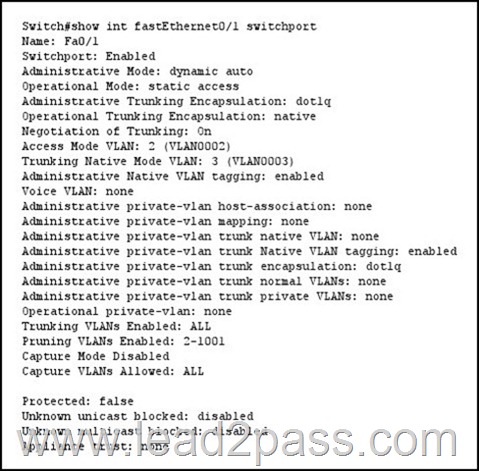
A. VLAN 1
B. VLAN 2
C. VLAN 3
D. VLAN 4
Answer: B
QUESTION 9
Refer to the exhibit. Which statement describes the effect on the network if FastEthernet0/1 goes down temporarily? 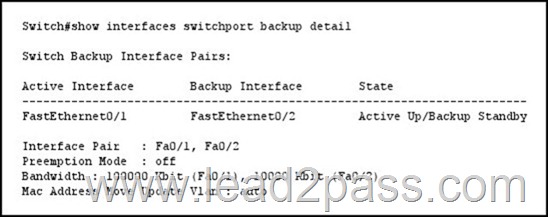
A. FastEthernet0/2 forwards traffic only until FastEthernet0/1 comes back up.
B. FastEthernet0/2 stops forwarding traffic until FastEthernet0/1 comes back up.
C. FastEthernet0/2 forwards traffic indefinitely.
D. FastEthernet0/1 goes into standby.
Answer: C
QUESTION 10
Refer to the exhibit. Routers R1, R2, and R3 are configured as shown, and traffic from R2 fails to reach 172.29.168.3.
Which action can you take to correct the problem? 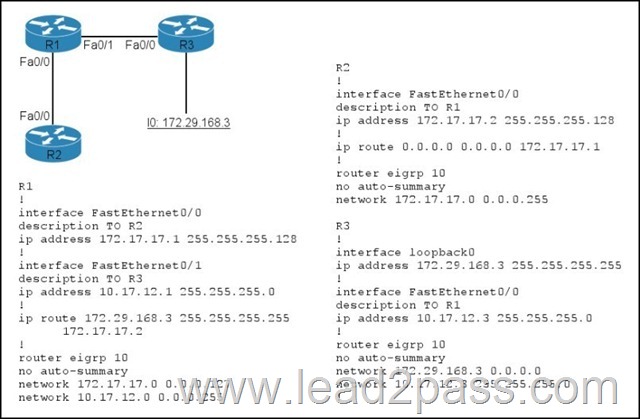
A. Correct the static route on R1.
B. Correct the default route on R2.
C. Edit the EIGRP configuration of R3 to enable auto-summary.
D. Correct the network statement for 172.29.168.3 on R3.
Answer: A
QUESTION 11
Refer to the exhibit. R3 prefers the path through R1 to reach host 10.1.1.1.
Which option describes the reason for this behavior? 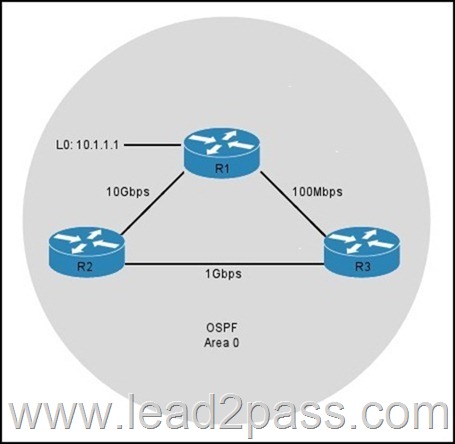
A. The OSPF reference bandwidth is too small to account for the higher speed links through R2.
B. The default OSPF cost through R1 is less than the cost through R2.
C. The default OSPF cost through R1 is more than the cost through R2.
D. The link between R2 and R1 is congested.
Answer: A
QUESTION 12
Refer to the exhibit. For which reason could a BGP-speaking device in autonomous system 65534 be prevented from installing the given route in its BGP table? 
A. The AS number of the BGP is specified in the given AS_PATH.
B. The origin of the given route is unknown.
C. BGP is designed only for publicly routed addresses.
D. The AS_PATH for the specified prefix exceeds the maximum number of ASs allowed.
E. BGP does not allow the AS number 65535.
Answer: A
QUESTION 13
Which statement about the feasibility condition in EIGRP is true?
A. The prefix is reachable via an EIGRP peer that is in the routing domain of the router.
B. The EIGRP peer that advertises the prefix to the router has multiple paths to the destination.
C. The EIGRP peer that advertises the prefix to the router is closer to the destination than the router.
D. The EIGRP peer that advertises the prefix cannot be used as a next hop to reach the destination.
Answer: C
QUESTION 14
Which two statements about the function of the stub feature in EIGRP are true? (Choose two.)
A. It stops the stub router from sending queries to peers.
B. It stops the hub router from sending queries to the stub router.
C. It stops the stub router from propagating dynamically learned EIGRP prefixes to the hub routers .
D. It stops the hub router from propagating dynamically learned EIGRP prefixes to the stub routers .
Answer: BC
QUESTION 15
In which type of EIGRP configuration is EIGRP IPv6 VRF-Lite available?
A. stub
B. named mode
C. classic mode
D. passive
Answer: B
QUESTION 16
Two routers are trying to establish an OSPFv3 adjacency over an Ethernet link, but the adjacency is not forming. Which two options are possible reasons that prevent OSPFv3 to form between these two routers? (Choose two.)
A. mismatch of subnet masks
B. mismatch of network types
C. mismatch of authentication types
D. mismatch of instance IDs
E. mismatch of area types
Answer: DE
QUESTION 17
Like OSPFv2, OSPFv3 supports virtual links.Which two statements are true about the IPv6 address of a virtual neighbor? (Choose two.)
A. It is the link-local address, and it is discovered by examining the hello packets received from the
virtual neighbor.
B. It is the link-local address, and it is discovered by examining link LSA received by the virtual neighbor.
C. It is the global scope address, and it is discovered by examining the router LSAs received by the
virtual neighbor.
D. Only prefixes with the LA-bit not set can be used as a virtual neighbor address.
E. It is the global scope address, and it is discovered by examining the intra-area-prefix-LSAs received
by the virtual neighbor.
F. Only prefixes with the LA-bit set can be used as a virtual neighbor address.
Answer: EF
QUESTION 18
Which field is specific to the OPSFv3 packet header, as opposed to the OSPFv2 packet header?
A. checksum
B. router ID
C. AuType
D. instance ID
Answer: D
QUESTION 19
Which two functions are performed by the DR in OSPF? (Choose two.)
A. The DR originates the network LSA on behalf of the network.
B. The DR is responsible for the flooding throughout one OSPF area.
C. The DR forms adjacencies with all other OSPF routers on the network, in order to synchronize the
LSDB across the adjacencies.
D. The DR is responsible for originating the type 4 LSAs into one area.
Answer: AC
QUESTION 20
Refer to the exhibit. AS #1 and AS #2 have multiple EBGP connections with each other. AS #1 wants all return traffic that is destined to the prefix 10.10.10.1/32 to enter through the router R1 from AS #2. In order to achieve this routing policy, the AS 1 advertises a lower MED from R1, compared to a higher MED from R3, to their respective BGP neighbor for the prefix 10.10.10.0/24. Will this measure guarantee that the routing policy is always in effect? 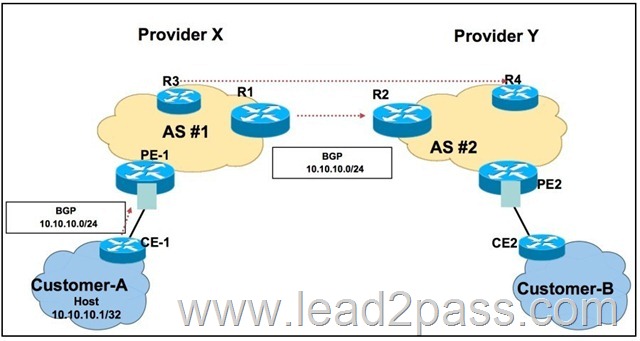
A. Yes, because MED plays a deterministic role in return traffic engineering in BGP.
B. Yes, because a lower MED forces BGP best-path route selection in AS #2 to choose R1 as the
best path for 10.10.10.0/24.
C. Yes, because a lower MED in AS #2 is the highest BGP attribute in BGP best-path route selection.
D. No, AS #2 can choose to alter the weight attribute in R2 for BGP neighbor R1, and this weight value
is cascaded across AS #2 for BGP best-path route selection.
E. No, AS #2 can choose to alter the local preference attribute to overwrite the best-path route selection
over the lower MED advertisement from AS #1. This local preference attribute is cascaded across AS #2
for the BGP best-path route selection.
Answer: E
QUESTION 21
Which regular expression will only allow prefixes that originated from AS 65000 and that are learned through AS 65001?
A. ^65000_65001$
B. 65000_65001$
C. ^65000_65001
D. ^65001_65000$
Answer: D
QUESTION 22
Which statement describes the BGP add-path feature?
A. It allows for installing multiple IBGP and EBGP routes in the routing table.
B. It allows a network engineer to override the selected BGP path with an additional path created in
the config.
C. It allows BGP to provide backup paths to the routing table for quicker convergence.
D. It allows multiple paths for the same prefix to be advertised.
Answer: D
QUESTION 23
Refer to the exhibit. What does “(received-only)” mean? 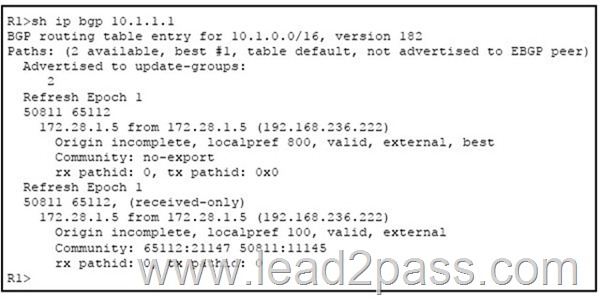
A. The prefix 10.1.1.1 can not be advertised to any eBGP neighbor.
B. The prefix 10.1.1.1 can not be advertised to any iBGP neighbor.
C. BGP soft reconfiguration outbound is applied.
D. BGP soft reconfiguration inbound is applied.
Answer: D
QUESTION 24
Refer to the exhibit. Which statement is true? 
A. There is no issue with forwarding IPv6 traffic from this router.
B. IPv6 traffic can be forwarded from this router, but only on Ethernet1/0.
C. IPv6 unicast routing is not enabled on this router.
D. Some IPv6 traffic will be blackholed from this router.
Answer: D
QUESTION 25
Refer to the exhibit. What is a reason for the RIB-failure? 
A. CEF is not enabled on this router.
B. The route 10.100.1.1/32 is in the routing table, but not as a BGP route.
C. The routing table has yet to be updated with the BGP route.
D. The BGP route is filtered inbound and hence is not installed in the routing table.
Answer: B
Always up-to-date Lead2pass 400-101 VCE – everything you need for your Cisco 400-101 exam to pass. Our Cisco 400-101 software allows you to practise exam dumps in real 400-101 exam environment. Welcome to choose.
400-101 new questions on Google Drive: https://drive.google.com/open?id=0B3Syig5i8gpDU2RjeUlHTTZXb1U
2016 Cisco 400-101 exam dumps (All 1219 Q&As) from Lead2pass:
http://www.lead2pass.com/400-101.html [100% Exam Pass Guaranteed]